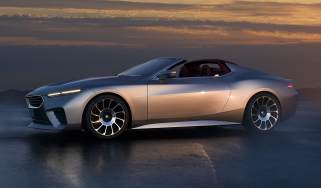Brake failure on the Millbrook straight – evo archive
Millbrook’s two-way straight was daunting at the best of times. Throw in a bit of brake failure, and…

Almost from the moment the rules were changed it seemed utterly bonkers that we thought the old way was in any sense acceptable. The mile straight at Millbrook Proving Ground is a perfectly flat, perfectly straight piece of tarmac stretching for just over a mile (I know, trade descriptions should have been all over them). Today it is only ever used in one direction, but back in 2006 you could run both ways. Just to be clear, that meant you could have two cars heading towards each other flat-out, like some latter-day jousting match with wing mirrors. You’re probably imagining that there was a sturdy barrier separating the two lanes. But, no. Keeping the cars safely apart as they hurtled towards each other with a closing speed of somewhere around 300mph was… a painted white line.
Most of the time this terrifying scenario was avoided by only needing to test one car, but when we did our Fast Club features there was a lot of figuring to be done in a day. As I say, at the time we really didn’t think too much about the danger and, as far as I recall, we didn’t wear Nomex. What’s more, I’m pretty sure we only used to wear helmets for the photos – when we were actually testing it was easier to hear the numbers being called if you weren’t wearing an Arai. And if you’re wondering why a passenger shouted the speed, it was so that the driver could keep his eyes on the amount of mile left but also didn’t irritatingly wimp out at 169.5mph. Now I think about it, I should have called the numbers in a bingo style: ‘Like the R, 130.’
> BMW M6: review, specs and buying guide
Anyway, for the 2006 Fast Club story in issue 091 I was sitting in the silly seat, running the timing gear and calling the numbers that day, and I remember two cars in particular for totally different reasons. The launch technique for the B7 RS4 has always stayed with me for its sheer brutality. John Barker found that the way to the best time was simply to dial in the full 8250rpm and then sidestep the clutch. No finesse, incredible sound, staggering traction, astonishing mechanical robustness.
The other car I remember vividly is the BMW M6. Jethro Bovingdon was the man extracting the performance from its naturally aspirated V10 and it was tricky not to vaporise the rear rubber off the line. However, it wasn’t the acceleration but rather the deceleration that really quickened the pulse. Heading down the two-way mile straight I remember Jethro hitting the brakes for a full-on, tap-the-dashboard emergency stop, only to see a bank of warning lights illuminate like a cheap fairground ride. At the worst possible moment the M6 had effectively thrown up its hands and said, ‘You’re on your own,’ while promptly locking its rear wheels as the ABS, EBD and ESP all stood idly by.
Thankfully Jethro applied an impressively swift and accurate amount of opposite lock to keep the car on our side of the protective white line and there was enough room to ease off the brakes and slow down more sedately. I think we laughed nervously as we rolled to a stop, both well aware that the result of full brake failure in the direction we were heading was to be launched up some banking, out of the proving ground and onto a railway line.
Of course, having switched the car off and back on again to reset it, we turned round and did it all again the other way.





